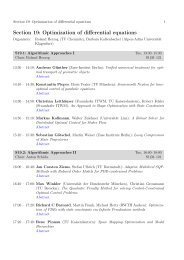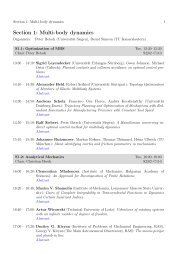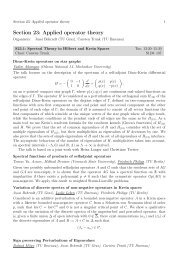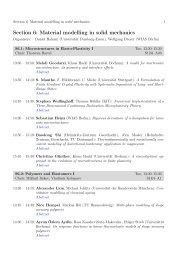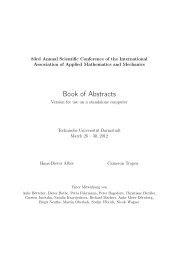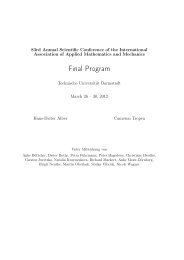Section 6: Material modelling in solid mechanics - GAMM 2012
Section 6: Material modelling in solid mechanics - GAMM 2012
Section 6: Material modelling in solid mechanics - GAMM 2012
You also want an ePaper? Increase the reach of your titles
YUMPU automatically turns print PDFs into web optimized ePapers that Google loves.
<strong>Section</strong> 6: <strong>Material</strong> <strong>modell<strong>in</strong>g</strong> <strong>in</strong> <strong>solid</strong> <strong>mechanics</strong> 17<br />
frame.<br />
Start<strong>in</strong>g from balance of mass, l<strong>in</strong>ear momentum, <strong>in</strong>ternal energy and employ<strong>in</strong>g method<br />
of weighted residuals, we get a non-l<strong>in</strong>ear coupled set of partial differential equations <strong>in</strong> space<br />
and time. A space discretization <strong>in</strong> f<strong>in</strong>ite elements method and a time discretization <strong>in</strong> f<strong>in</strong>ite<br />
difference method leads to an approximation after a successful l<strong>in</strong>earization. We achieve to solve<br />
the problem without any stabilization or usage of specific type of elements and show here the<br />
entropy production and its variation subject to material parameters for the sake of a better<br />
<strong>in</strong>tuitive understand<strong>in</strong>g of dissipation. This may lead to an <strong>in</strong>verse problem where the calculated<br />
dissipation is measured and material parameters are determ<strong>in</strong>ed out of it, which is left to future<br />
research.<br />
S6.7: Phase Transformations II Wed, 16:00–18:00<br />
Chair: Wolfgang Dreyer S1|01–A03<br />
Nons<strong>in</strong>gular Dislocation Loops <strong>in</strong> Gradient Elasticity<br />
Markus Lazar (TU Darmstadt)<br />
This work studies the fundamental problem of nons<strong>in</strong>gular dislocations <strong>in</strong> the framework of the<br />
theory of gradient elasticity. A general theory of nons<strong>in</strong>gular dislocations is developed for l<strong>in</strong>early<br />
elastic, <strong>in</strong>f<strong>in</strong>itely extended, homogeneous, isotropic media. Us<strong>in</strong>g gradient elasticity, we give the<br />
nons<strong>in</strong>gular fields produced by arbitrary dislocation loops. We present the ‘modified’ Mura, Peach-<br />
Koehler and Burgers formulae <strong>in</strong> the framework of gradient elasticity theory. These formulae are<br />
given <strong>in</strong> terms of an elementary function, which regularizes the classical expressions, obta<strong>in</strong>ed<br />
from the Green tensor of generalized Navier equations. Us<strong>in</strong>g the mathematical method of Green’s<br />
functions and the Fourier transform, we found exact, analytical and nons<strong>in</strong>gular solutions. The<br />
obta<strong>in</strong>ed dislocation fields are nons<strong>in</strong>gular due to the regularization of the classical s<strong>in</strong>gular fields.<br />
On a paradox with<strong>in</strong> the phase field model<strong>in</strong>g of storage systems and its resolution<br />
Clemens Guhlke, Wolfgang Dreyer (WIAS Berl<strong>in</strong>)<br />
We study two import storage problems: The storage of lithium <strong>in</strong> an electrode of a lithium-ion<br />
battery and the storage of hydrogen <strong>in</strong> hydrides.<br />
When foreign atoms are reversibly stored <strong>in</strong> a crystal, there may be a regime where two coexist<strong>in</strong>g<br />
phases with low and high concentration of the stored atoms occur. Furthermore hysteretic<br />
behavior can be observed, i.e. the processesof load<strong>in</strong>g and unload<strong>in</strong>g follow different paths.<br />
We apply a viscous Cahn-Hilliard model with mechanical coupl<strong>in</strong>g to calculate the voltagecharge<br />
diagram of the battery, respectively the pressure-charge diagram of a hydrogen system.<br />
The diagrams exhibit phase transition and hysteresis. However, we show that the model can only<br />
describe the observed phenomena for fast but nor for slow load<strong>in</strong>g.<br />
We relate the reason for failure to the microstructure of modern storage systems. In fact these<br />
consist of an ensemble of nano-sized <strong>in</strong>terconnected storage particle. Each particle is described by<br />
a non-monotone chemical potential function but on the time scale of slow load<strong>in</strong>g of the ensemble,<br />
the coexist<strong>in</strong>g phases are unstable with<strong>in</strong> an <strong>in</strong>dividual particle and cannot be observed on the<br />
time scale of the load<strong>in</strong>g.<br />
In the slow load<strong>in</strong>g regime, the occurence of two coexist<strong>in</strong>g phases phases is a many-particle<br />
effect of the ensemble. The nucleation and evolution of the phases is embodied by a nonlocal<br />
conservation law of Fokker-Planck type.<br />
Numerical Simulation of Coarsen<strong>in</strong>g <strong>in</strong> Metallic Alloys<br />
Uli Sack, Carsten Gräser, Ralf Kornhuber (FU Berl<strong>in</strong>)



